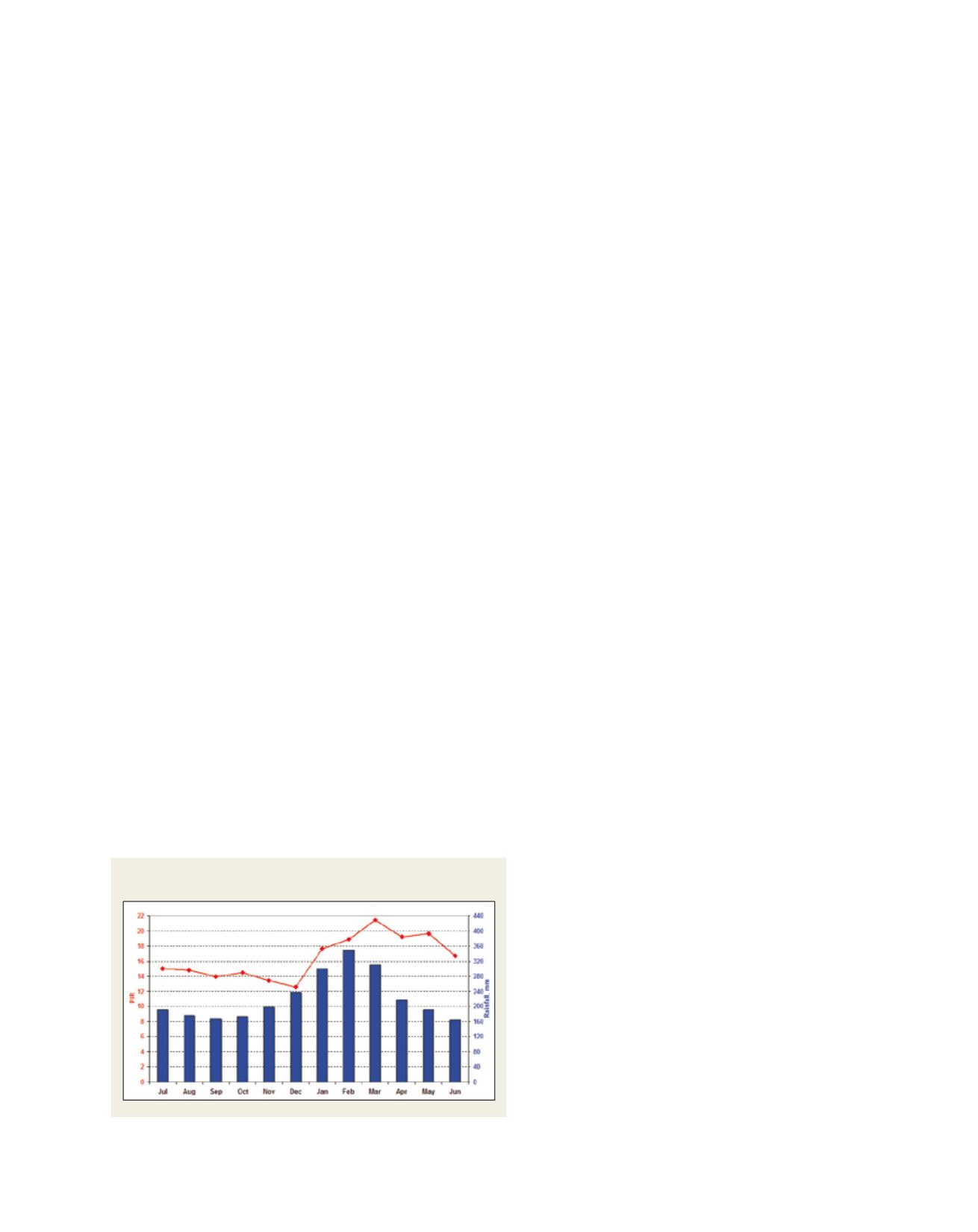

[
] 103
H
ealth
Data for the central (including Central, Guadalcanal,
Isobel and Honiara provinces) and western (including
Western and Choiseul provinces) regions were aggre-
gated, while the provinces of Makir, Temotu and Malaita
were treated as separate regions. The grouping of data in
this way gave significant consideration to geographical
location, orographic effects and the availability of malaria
outpatients and climate data. Considerable adjustments
were made to population data and the associated records
on malaria incidence to reflect the groupings, and the
malarial incidence was calculated as a Positive Incidence
Ratio (PIR), which is defined as the number of positive
films per 1,000 head of population.
The numbers of confirmed malaria cases were iden-
tified using data from 1975-2008 during the peak
infection period (December to May). Linear and
non-linear regression techniques were used to relate
PIR to climate (temperature and rainfall) and non-
climate (for example, population growth) factors.
The analyses show that incidence of malaria peaks
during the wet season (December to April). However,
it was also evident that, somewhat counter-intuitively,
above median rainfall during this peak period tends
to suppress the number of malaria cases. The likely
cause is a flushing out of mosquito breeding sites by
the heavier than normal rainfall. Conversely, below-
median rainfall during the wet season tends to increase
the incidence of malaria.
Together these results indicate that malaria would
tend to be more prevalent during El Niño events and
less so during La Niña events. The maximum correla-
tion between rainfall and PIR is subject to a significant
lag time, with PIR lagging rainfall by approximately
two months. This makes rainfall a useful param-
eter for forecasting PIR with sufficient lead time to
inform planning and management decisions. On the
other hand, temperature influence on the number
of malaria cases tends to have a shorter lag period,
hence lower than normal rainfall from November to
January followed by higher than normal temperatures
in December and January triggers a high incidence of
malaria in the Solomon Islands.
Health data collected from SIMTRI showed that the
PIR was relatively high from 1990 through to 1995,
at a time when El Niño patterns prevailed from April
1991 to March 1995. Five out of six November-April
rainfall totals were below average during this period.
Climate factors (rainfall and temperature) explained
up to 70 per cent of variability in the number of
malaria cases. An early warning system for malaria
based on seasonal climate forecasts for the peak infec-
tion period was therefore assessed to be viable for the
Solomon Islands.
It is also noteworthy that projections of future climate
suggest an increasing trend toward higher temperatures
and no significant change in the rainfall pattern for the
Solomon Islands, which could pose a future increased
risk of malaria and therefore an increased urgency for
the development of improved management strategies.
Tackling malaria
Malaria is a primary focus of one of the United Nations Development
Programme (UNDP) Millennium Development Goals
2
and remains
one of the most widespread and devastating infectious diseases in
tropical developing countries around the world.
The Solomon Islands is no exception, where malaria is a leading
cause of death. World Health Organization data published in April
2011 showed a malarial death rate of approximately eight per cent
of total deaths. The age-adjusted death rate of approximately 30 per
100,000 of population ranks the Solomon Islands as 33rd in the
world. Malaria continues to have a high cost in both economic and
social terms in the Solomon Islands, with low productivity at work
and absenteeism in schools.
In the Solomon Islands,
Plasmodium falciparum,
the severe and life-
threatening form of malaria parasite, accounts for 60-70 per cent of
all confirmed cases. As mosquitoes are the carrier of this disease,
worldwide malarial epidemics tend to occur when environmental
conditions such as rainfall, temperature and relative humidity create
optimal conditions for mosquito breeding.
The climate of the Solomon Islands is significantly influenced by
the ENSO phenomenon. El Niño conditions are generally associated
with below-average rainfall and above-average temperatures, while
La Niña conditions are generally associated with above-average rain-
fall and below-average temperatures. The tendency for an ENSO
state to develop and persist once it is initiated makes it possible
to forecast seasonal rainfall and other hydroclimatic variables with
some accuracy, employing key climate indices such as the Southern
Oscillation Index and patterns of Sea Surface Temperature anom-
alies. Therefore there is potential to forecast the elevated risk of
malaria outbreaks in the Solomon Islands with sufficient lead time
to reduce the potential incidence of the disease through targeted
control strategies.
Lessons from data
In collaboration with SIMTRI, records of both confirmed and
suspected (unconfirmed) malaria cases for nine provinces were
obtained for the period 1975-2007. Corresponding climate data for
this period, including rainfall, maximum and minimum temperature
and relative humidity data, were prepared by SIMS.
Records were collected for each of the nine Solomon Island prov-
inces and were collated into five regions for the purpose of this study.
Average monthly PIR and rainfall for the Solomon Islands,
1975-2007
Source: Australian Bureau of Meteorology
















